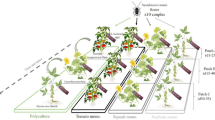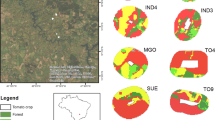Abstract
Conservation biological control involves manipulation of the environment to enhance the effectiveness of natural enemies in controlling crop pests. In this study, we combined historical data, sticky trap sampling of tomato greenhouses and beat sampling of adjacent vegetation to identify which greenhouse characteristics, habitat management practices and landscape features favour an early colonisation of tomato greenhouses by the key mirid predator Macrolophus pygmaeus and its establishment in NE Spain. Results show that landscape composition and the use of Calendula officinalis banker plants inside the greenhouse are key factors. In general, greater amounts of herbaceous semi-natural cover at the landscape scale promoted M. pygmaeus colonisation, while the use of C. officinalis banker plants encouraged M. pygmaeus colonisation independently of the landscape context. We identified host plants adjacent to tomato greenhouses that sustain M. pygmaeus populations; however, they did not have a major effect on M. pygmaeus colonisation compared to larger landscape and banker plant effects. Early colonisation of greenhouses by this predator species also translated into lower accumulated incidence of pests at the end of the sampling period. This study demonstrates the importance of active habitat management practices in promoting the early arrival of M. pygmaeus in greenhouses with delayed spontaneous colonisation.


Similar content being viewed by others
Availability of data and material
Available from corresponding author.
Code availability
Not applicable.
References
Agustí N, Castañé C, Fraile I, Alomar Ò (2020) Development of a PCR-based method to monitor arthropod dispersal in agroecosystems: Macrolophus pygmaeus (Hemiptera: Miridae) from banker plants to tomato crops. Insect Sci 27:1125–1134. https://doi.org/10.1111/1744-7917.12717
Albajes R, Alomar Ò (1999) Current and potential use of polyphagous predators. In: Albajes R, Gullino ML, van Lenteren JC, Elad Y (eds) Integrated pest and disease management in greenhouse crops. Kluwer Academic Publishers, Dordrecht, pp 265–275
Alomar Ò, Goula M, Albajes R (2002) Colonisation of tomato fields by predatory mirid bugs (Hemiptera: Heteroptera) in northern Spain. Agric Ecosyst Environ 89:105–115. https://doi.org/10.1016/S0167-8809(01)00322-X
Alomar Ò, Gabarra R, Gonzalez O, Castañé C (2006) Selection of insectary plants for ecological infrastructure in Mediterranean vegetable crops. In: IOBC-WPRS Bulletin. pp 5–8
Arnó J, Castañé C, Riudavets J, Gabarra R (2010) Risk of damage to tomato crops by the generalist zoophytophagous predator Nesidiocoris tenuis (Reuter) (Hemiptera: Miridae). Bull Entomol Res 100:105–115. https://doi.org/10.1017/S0007485309006841
Arnó J, Castañé C, Alomar Ò et al (2018) Forty years of biological control in Mediterranean tomato greenhouses: the story of success. Isr J Entomol 48:20–29. https://doi.org/10.5281/zenodo.1486574
Aviron S, Poggi S, Varennes YD, Lefèvre A (2016) Local landscape heterogeneity affects crop colonization by natural enemies of pests in protected horticultural cropping systems. Agric Ecosyst Environ 227:1–10. https://doi.org/10.1016/j.agee.2016.04.013
Balzan MV (2017) Flowering banker plants for the delivery of multiple agroecosystem services. Arthropod Plant Interact 11:743–754. https://doi.org/10.1007/s11829-017-9544-2
Bianchi FJJA, Booij CJH, Tscharntke T (2006) Sustainable pest regulation in agricultural landscapes: a review on landscape composition, biodiversity and natural pest control. Proc Biol Sci 273:1715–27. https://doi.org/10.1098/rspb.2006.3530
Burnham KP, Anderson DR (2002) Model selection and multimodel inference. Springer, New York
Calvo J, Bolckmans K, Stansly PA, Urbaneja A (2009) Predation by Nesidiocoris tenuis on Bemisia tabaci and injury to tomato. Biocontrol 54:237–246. https://doi.org/10.1007/s10526-008-9164-y
Castañé C, Alomar Ò, Goula M, Gabarra R (2004) Colonization of tomato greenhouses by the predatory mirid bugs Macrolophus caliginosus and Dicyphus tamaninii. Biol Control 30:591–597. https://doi.org/10.1016/j.biocontrol.2004.02.012
Castañé C, Arnó J, Gabarra R, Alomar Ò (2011) Plant damage to vegetable crops by zoophytophagous mirid predators. Biol Control 59:22–29. https://doi.org/10.1016/j.biocontrol.2011.03.007
Castañé C, Agustí N, Arnó J et al (2013) Taxonomic identification of Macrolophus pygmaeus and Macrolophus melanotoma based on morphometry and molecular markers. Bull Entomol Res 103:204–215. https://doi.org/10.1017/S0007485312000545
Castañé C, Agustí N, Alomar Ò (2016) The use of mirids and anthocorid bugs as polyphagous predators in greenhouse crops. IOBC-WPRS Bull 119:2–6
Clemente-Orta G, Madeira F, Batuecas I et al (2020) Changes in landscape composition influence the abundance of insects on maize: The role of fruit orchards and alfalfa crops. Agric Ecosyst Environ 291:106805. https://doi.org/10.1016/j.agee.2019.106805
Gabarra R, Alomar Ò̀, Castañé C et al (2004) Movement of greenhouse whitefly and its predators between in- and outside of Mediterranean greenhouses. Agric Ecosyst Environ 102:341–348. https://doi.org/10.1016/j.agee.2003.08.012
Guisan A, Zimmermann NE (2000) Predictive habitat distribution models in ecology. Ecol Modell 135:147–186. https://doi.org/10.1016/S0304-3800(00)00354-9
Gurr GM, Wratten SD, Landis DA, You M (2017) Habitat management to suppress pest populations: progress and prospects. Annu Rev Entomol 62:91–109. https://doi.org/10.1146/annurev-ento-031616-035050
Haenke S, Scheid B, Schaefer M et al (2009) Increasing syrphid fly diversity and density in sown flower strips within simple vs. complex landscapes. J Appl Ecol 46:1106–1114. https://doi.org/10.1111/j.1365-2664.2009.01685.x
Ingegno B, Pansa M, Tavella L (2009) Tomato colonization by predatory bugs (Heteroptera: Miridae) in agroecosystems of NW Italy. IOBC/WPRS Bull. 49:287–291
Ingegno BL, Pansa MG, Tavella L (2011) Plant preference in the zoophytophagous generalist predator Macrolophus pygmaeus (Heteroptera: Miridae). Biol Control 58:174–181. https://doi.org/10.1016/j.biocontrol.2011.06.003
Jonsson M, Straub CS, Didham RK et al (2015) Experimental evidence that the effectiveness of conservation biological control depends on landscape complexity. J Appl Ecol 52:1274–1282. https://doi.org/10.1111/1365-2664.12489
Lambion J (2014) Flower strips as winter shelters for predatory Miridae bugs. Acta Hortic 1041:149–156
Landis DA, Wratten SD, Gurr GM (2000) Habitat management to conserve natural enemies of arthropod pests. Annu Rev Entomol 45:175–201
Letourneau DK, Armbrecht I, Salguero Rivera B et al (2011) Does plant diversity benefit agroecosystems? A synthetic review. Ecol Appl 21:9–21. https://doi.org/10.1890/09-2026.1
Li S, Jaworski CC, Hatt S et al (2020) Flower strips adjacent to greenhouses help reduce pest populations and insecticide applications inside organic commercial greenhouses. J Pest Sci. https://doi.org/10.1007/s10340-020-01285-9
Lykouressis D, Perdikis D, Tsagarakis A (2001) Polyphagous mirids in Greece: host plants and abundance in traps placed in some crops. Boll Del Lab Di Entomol Agrar Filippo Silvestri 56:57–68
Martinez-Cascales JI, Cenis JL, Cassis G, Sanchez JA (2006) Species identity of Macrolophus melanotoma (Costa 1853) and Macrolophus pygmaeus (Rambur 1839) (Insecta: Heteroptera: Miridae) based on morphological and molecular data and bionomic implications. Insect Syst Evol 37:385–404. https://doi.org/10.1163/187631206788831470
Martínez-García H, Sáenz-Romo MG, Aragón-Sánchez M et al (2017) Temperature-dependent development of Macrolophus pygmaeus and its applicability to biological control. Biocontrol 62:481–493. https://doi.org/10.1007/s10526-017-9798-8
Messelink GJ, Bennison J, Alomar O et al (2014) Approaches to conserving natural enemy populations in greenhouse crops: current methods and future prospects. Biocontrol 59:377–393. https://doi.org/10.1007/s10526-014-9579-6
Moerkens R, Berckmoes E, Van Damme V et al (2017) Inoculative release strategies of Macrolophus pygmaeus Rambur (Hemiptera: Miridae) in tomato crops: population dynamics and dispersal. J Plant Dis Prot 124:295–303. https://doi.org/10.1007/s41348-017-0077-9
Montserrat M, Albajes R, Castañé C (2004) Behavioral responses of three plant-inhabiting predators to different prey densities. Biol Control 30:256–264. https://doi.org/10.1016/j.biocontrol.2004.01.006
Norris RF, Kogan M (2005) Ecology of interactions between weeds and arthropods. Annu Rev Entomol 50:479–503. https://doi.org/10.1146/annurev.ento.49.061802.123218
Paradis E, Schliep K (2019) Ape 5.0: An environment for modern phylogenetics and evolutionary analyses in R. Bioinformatics 35:526–528. https://doi.org/10.1093/bioinformatics/bty633
Perdikis DC, Margaritopoulos JT, Stamatis C et al (2003) Discrimination of the closely related biocontrol agents Macrolophus melanotoma (Hemiptera: Miridae) and M. pygmaeus using mitochondrial DNA analysis. Bull Entomol Res 93:507–514. https://doi.org/10.1079/ber2003265
Perdikis D, Fantinou A, Lykouressis D (2011) Enhancing pest control in annual crops by conservation of predatory Heteroptera. Biol Control 59:13–21. https://doi.org/10.1016/j.biocontrol.2011.03.014
Ricci B, Lavigne C, Alignier A et al (2019) Local pesticide use intensity conditions landscape effects on biological pest control. Proc R Soc B Biol Sci 286:20182898. https://doi.org/10.1098/rspb.2018.2898
Sanchez JA (2008) Zoophytophagy in the plantbug Nesidiocoris tenuis. Agric for Entomol 10:75–80. https://doi.org/10.1111/j.1461-9563.2007.00357.x
Sanchez JA, López-Gallego E, Pérez-Marcos M et al (2018) How safe is it to rely on Macrolophus pygmaeus (Hemiptera: Miridae) as a biocontrol agent in tomato crops? Front Ecol Evol 6:1–10. https://doi.org/10.3389/fevo.2018.00132
Sanchez JA, López-Gallego E, Pérez-Marcos M, Perera-Fernández L (2020) The effect of banker plants and pre - plant release on the establishment and pest control of Macrolophus pygmaeus in tomato greenhouses. J Pest Sci. https://doi.org/10.1007/s10340-020-01257-z
Schellhorn NA, Bianchi FJJA, Hsu CL (2014) Movement of entomophagous arthropods in agricultural landscapes: links to pest suppression. Annu Rev Entomol 59:559–581. https://doi.org/10.1146/annurev-ento-011613-161952
Schellhorn NA, Gagic V, Bommarco R (2015) Time will tell: resource continuity bolsters ecosystem services. Trends Ecol Evol. https://doi.org/10.1016/j.tree.2015.06.007
Symondson WOC, Sunderland KD, Greenstone MH (2002) Can generalist predators be effective biocontrol agents? Annu Rev Entomol 47:561–594
Thies C, Tscharntke T (1999) Landscape structure and biological control in agroecosystems. Science 285:893–895. https://doi.org/10.1126/science.285.5429.893
Thomine E, Jeavons E, Rusch A et al (2020) Effect of crop diversity on predation activity and population dynamics of the mirid predator Nesidiocoris tenuis. J Pest Sci. https://doi.org/10.1007/s10340-020-01222-w
Tooker JF, O’Neal ME, Rodriguez-Saona C (2020) Balancing disturbance and conservation in agroecosystems to improve biological control. Annu Rev Entomol 65:81–100. https://doi.org/10.1146/annurev-ento-011019-025143
Tscharntke T, Bommarco R, Clough Y et al (2007) Conservation biological control and enemy diversity on a landscape scale. Biol Control 43:294–309. https://doi.org/10.1016/j.biocontrol.2007.08.006
Wickham H (2009) ggplot2: elegant graphics for data analysis. Springer, New York
Wiedenmann RN, Smith JW (1997) Attributes of natural enemies in ephemeral crop habitats. Biol Control 10:16–22. https://doi.org/10.1006/bcon.1997.0544
Wissinger SA (1997) Cyclic colonization in predictably ephemeral habitats: a template for biological control in annual crop systems. Biol Control 10:4–15. https://doi.org/10.1006/bcon.1997.0543
Acknowledgements
We thank the EU-funded projects, EUCLID (Project Number: 633999-2) and EMPHASIS (Project Number: 634179-2), the project AGL2016-77373-C2-1-R (Spanish Ministry of Economy and Competitiveness) and the CERCA Programme of the Generalitat de Catalunya. AA was partly supported by a Ramón Areces fellowship while writing this manuscript. We would like to thank the growers of the Associació de Defensa Vegetal del Baix Maresme for kindly allowing the authors to operate in their greenhouses. Big thanks to the Entomology group at IRTA Cabrils for their help and support during the development of this work.
Funding
This study was funded by EU-funded projects, EUCLID (Project Number: 633999-2) and EMPHASIS (Project Number: 634179-2), the project AGL2016-77373-C2-1-R (Spanish Ministry of Economy and Competitiveness) and the CERCA Programme of the Generalitat de Catalunya. AA was partly supported by a Ramón Areces fellowship while writing this manuscript.
Author information
Authors and Affiliations
Corresponding author
Ethics declarations
Conflicts of interest
None.
Ethical approval
Not applicable.
Additional information
Communicated by Mattias Jonsson.
Publisher's Note
Springer Nature remains neutral with regard to jurisdictional claims in published maps and institutional affiliations.
Supplementary Information
Below is the link to the electronic supplementary material.
Rights and permissions
About this article
Cite this article
Ardanuy, A., Figueras, M., Matas, M. et al. Banker plants and landscape composition influence colonisation precocity of tomato greenhouses by mirid predators. J Pest Sci 95, 447–459 (2022). https://doi.org/10.1007/s10340-021-01387-y
Received:
Revised:
Accepted:
Published:
Issue Date:
DOI: https://doi.org/10.1007/s10340-021-01387-y




